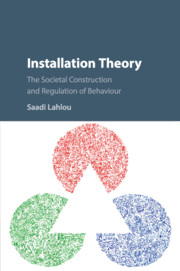Book contents
- Installation Theory
- Installation Theory
- Copyright page
- Dedication
- Contents
- Figures
- Plates
- Foreword
- Acknowledgements
- Introduction
- Chapter 1 Installation
- Chapter 2 The Problem of Human Action and the Problem of Social Regulation
- Chapter 3 Theoretical Frameworks Grounding Installation Theory
- Chapter 4 The Structure of Installations
- Chapter 5 Endurance of Installations
- Chapter 6 Selection Mechanisms in Societal Evolution
- Chapter 7 The Evolution of Installations
- Chapter 8 Redesigning Installations to Change Behaviour
- Chapter 9 Conclusion
- Glossary
- References
- Index
Chapter 4 - The Structure of Installations
Published online by Cambridge University Press: 28 December 2017
- Installation Theory
- Installation Theory
- Copyright page
- Dedication
- Contents
- Figures
- Plates
- Foreword
- Acknowledgements
- Introduction
- Chapter 1 Installation
- Chapter 2 The Problem of Human Action and the Problem of Social Regulation
- Chapter 3 Theoretical Frameworks Grounding Installation Theory
- Chapter 4 The Structure of Installations
- Chapter 5 Endurance of Installations
- Chapter 6 Selection Mechanisms in Societal Evolution
- Chapter 7 The Evolution of Installations
- Chapter 8 Redesigning Installations to Change Behaviour
- Chapter 9 Conclusion
- Glossary
- References
- Index
Summary
This chapter describes the structure and nature of installations.
It first sketches their threefold structure, and then details each of the layers: the material environment, the embodied interpretive competences, the social regulation. It addresses, from the perspective of the actor, how activity is determined by these three layers of components, locally acting jointly as ‘installations’.
It illustrates the content of these layers with examples from activities such as changing a flat tyre on a roadside, tightening a bolt in a nuclear plant, taking orders in a four-star restaurant, preparing medications for patients in a hospital, intubating a patient in an intensive care unit and searching a suspect in a stop-and-search police procedure.
Section 4.1 gives an overview of installations’ structure; Sections 4.2, 4.3 and 4.4 describe their three layers of components.
The last part of each section is dedicated to the operationalization of the concepts: how the researcher can in practice extract these components from the empirical material.
Section 4.5 shows how the redundancy of these layers makes installations resilient. That property will turn out essential for societal reproduction.
- Type
- Chapter
- Information
- Installation TheoryThe Societal Construction and Regulation of Behaviour, pp. 93 - 174Publisher: Cambridge University PressPrint publication year: 2018

